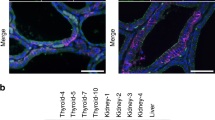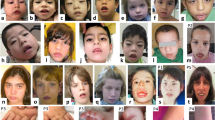Abstract
Pendred syndrome is a recessively inherited disorder with the hallmark features of congenital deafness and thyroid goitre. By some estimates, the disorder may account for upwards of 10% of hereditary deafness. Previous genetic linkage studies localized the gene to a broad interval on human chromosome 7q22–31.1. Using a positional cloning strategy, we have identified the gene (PDS) mutated in Pendred syndrome and found three apparently deleterious mutations, each segregating with the disease in the respective families in which they occur. PDS produces a transcript of approximately 5 kb that was found to be expressed at significant levels only in the thyroid. The predicted protein, pendrin, is closely related to a number of known sulphate transporters. These studies provide compelling evidence that defects in pendrin cause Pendred syndrome thereby launching a new area of investigation into thyroid physiology, the pathogenesis of congenital deafness and the role of altered sulphate transport in human disease.
This is a preview of subscription content, access via your institution
Access options
Subscribe to this journal
Receive 12 print issues and online access
$209.00 per year
only $17.42 per issue
Buy this article
- Purchase on Springer Link
- Instant access to full article PDF
Prices may be subject to local taxes which are calculated during checkout
Similar content being viewed by others
References
Pendred, V. Deaf-mutism and goitre. Lancet ii, 532 (1896).
Reardon, W. & Trembath, R.C. Pendred syndrome. J. Med. Genet. 33, 1037–1040 (1996).
Reardon, W. et al. Pendred syndrome: 100 years of underascertainment. Q. J. Med. 90, 443–447 (1997).
Fraser, G.R. Association of congenital deafness with goitre (Pendred's syndrome): a study of 207 families. Ann. Hum. Genet. 28, 201–249 (1965).
Batsakis, J.G. & Nishiyama, R.H. Deafness with sporadic goiter. Arch. Otolaryngol. 76, 401–406 (1962).
Ilium, P., Kiaer, H.W., Hvidberg-Hansen, J. & Sondergaard, G. Fifteen cases of Pendred's syndrome: congenital deafness and sporadic goiter. Arch. Otolaryngol. 96, 297–304 (1972).
Johnsen, T., Sorensen, M.S., Feldt-Rasmussen, U. & Friis, J. The variable intrafamiliar expressivity in Pendred's syndrome. Clin. Otolaryngol. 14, 395–399 (1989).
Mondini, C. Anatomia surdi nati sectio: De Boroniensi scientarium et artium institute atque acedemia commnetarii. Bononiae 7, 419–431 (1791).
Johnsen, T., Jorgensen, M.B. & Johnsen, S. Mondini cochlea in Pendred's syndrome; a histological study. Acta Oto-Laryngol. 102, 239–247 (1986).
Johnsen, T., Larsen, C., Friis, J. & Hougaard-Jensen, F. Pendred's syndrome: acoustic, vestibular and radiological findings in 17 unrelated patients. J. Laryngol. Otol. 101, 1187–1192 (1987).
Sheffield, V.C. et al. Pendred syndrome maps to chromosome 7q21–34 and is caused by an intrinsic defect in thyroid iodine organification. Nature Genet. 12, 424–426 (1996).
Trotter, W.R. The association of deafness with thyroid dysfunction, fir. Med. Bull. 16, 92–98 (1960).
Bradley, D.J., Towle, H.C. & Young, W.S. 3rd. Alpha and beta thyroid hormone receptor (TR) gene expression during auditory neurogenesis: evidence for TR isoform-specific transcriptional regulation in vivo. Proc. Natl. Acad. Sci. USA 91, 439–443 (1994).
Van Middlesworth, L. & Morris, C.H. Audiogenic seizures and cochlear damage in rats after perinatal antithyroid treatment. Endocrinology 106, 1686–1690 (1980).
O'Malley, B.W. Jr., Li, D. & Turner, D.S. Hearing loss and cochlear abnormalities in the congenital hypothyroid (hyt/hyt) mouse. Hear. Res. 88, 181–189 (1995).
Deol, M.S. An experimental approach to the understanding and treatment of hereditary syndromes with congenital deafness and hypothyroidism. J. Med. Genet. 10, 235–242 (1973).
Uziel, A., Gabrion, J., Ohresser, M. & Legrand, C. Effects of hypothyroidism on the structural development of the organ of Corti in the rat. Acta Oto-Laryngol. 92, 469–480 (1981).
Takeda, K., Sakurai, A., DeGroot, L.J. & Refetoff, S. Recessive inheritance of thyroid hormone resistance caused by complete deletion of the protein-coding region of the thyroid hormone receptor beta gene. J. Clin. Endocrinol. Metab. 74, 49–55 (1992).
Takeda, K., Balzano, S., Sakurai, A., DeGroot, L.J. & Refetoff, S. Screening of nineteen unrelated families with generalized resistance to thyroid hormone for known point mutations in the thyroid hormone receptor beta gene and the detection of a new mutation. J. Clin. Invest. 87, 496–502 (1991).
Forrest, D., Erway, L.C., Ng, L., Altschuler, R. & Curran, T. Thyroid hormone receptor is essential for development of auditory function. Nature Genet. 13, 354–357 (1996).
Coyle, B. et al. Pendred syndrome (goitre and sensorineural hearing loss) maps to chromosome 7 in the region containing the nonsyndromic deafness gene DFNB4. Nature Genet. 12, 421–423 (1996).
Murray, J.C. et al. A comprehensive human linkage map with centimorgan density. Cooperative Human Linkage Center (CHLC). Science 265, 2049–2054 (1994).
Sheffield, V.C. et al. A collection of tri- and tetranucleotide repeat markers used to generate high quality, high resolution human genome-wide linkage maps. Hum. Mol. Genet. 4, 1837–1844 (1995).
Coucke, P. et al. The gene for Pendred syndrome is located between D7S501 and D7S692 in a 1.7-cM region on chromosome 7q. Genomics 40, 48–54 (1997).
Gausden, E. et al. Pendred syndrome: evidence for genetic homogeneity and further refinement of linkage. Med. Genet. 34, 126–129 (1997).
Green, E.D. et al. Systematic generation of sequence-tagged sites for physical mapping of human chromosomes: application to the mapping of human chromosome 7 using yeast artificial chromosomes. Genomics 11, 548–564 (1991).
Green, E.D. et al. Integration of physical, genetic and cytogenetic maps of human chromosome 7: isolation and analysis of yeast artificial chromosome clones for 117 mapped genetic markers. Hum. Mol. Genet. 3, 489–501 (1994).
Green, E.D. et al. A human chromosome 7 yeast artificial chromosome (YAC) resource: construction, characterization, and screening. Genomics 25, 170–183 (1995).
Bouffard, G.G. et al. A physical map of human chromosome 7: an integrated YAC contig map with average STS spacing of 79 kb. Genome Res. 7, 673–692 (1997).
Bouffard, G.G. et al. A collection of 1814 human chromosome 7-specific STSs. Genome Res. 7, 59–64 (1997).
Marra, M.A. et al. High throughput fingerprint analysis of large-insert clones. Genome Res.(in the press).
Hoglund, P. et al. Positional candidate genes for congenital chloride diarrhea suggested by high-resolution physical mapping in chromosome region 7q31. Genome Res. 6, 202–210 (1996).
Schuler, G.D. et al. A gene map of the human genome. Science 274, 540–546 (1996).
Uberbacher, E.C. & Mural, R.J. Locating protein-coding regions in human DNA sequences by a multiple sensor-neural network approach. Proc. Natl. Acad. Sci. USA 88, 261–11265 (1991).
Xu, Y., Mural, R., Shah, M. & Uberbacher, E. Recognizing exons in genomic sequence using GRAIL II. Genet. Eng. 16, 241–253 (1994).
Altschul, S.F., Gish, W., Miller, W., Myers, E.W. & Lipman, D.J. Basic local alignment search tool. J. Mol. Biol. 215, 403–410 (1990).
Gish, W. & States, D.J. Identification of protein coding regions by database similarity search. Nature Genet. 3, 266–272 (1993).
Schweinfest, C.W., Henderson, K.W., Suster, S., Kondoh, N. & Papas, T.S. Identification of a colon mucosa gene that is down-regulated in colon adenomas and adenocarcinomas. Proc. Natl. Acad. Sci. USA 90, 4166–4170 (1993).
Byeon, M.K. et al. The down-regulated in adenoma (DRA) gene encodes an intestine-specific membrane glycoprotein. Oncogene 12, 387–396 (1996).
Silberg, D.G., Wang, W., Moseley, R.H. & Traber, P.G. The down regulated in adenoma (dra) gene encodes an intestine-specific membrane sulfate transport protein. j Biol. Chem. 270, 11897–11902 (1995).
Hoglund, P. et al. Mutations of the down-regulated in adenoma (DRA) gene cause congenital chloride diarrhoea. Nature Genet. 14, 316–319 (1996).
Kozak, M. Interpreting cDNA sequences: some insights from studies on translation. Mamm. Genome 7, 563–574 (1996).
Kozak, M. Regulation of translation in eukaryotic systems. Annu. Rev. Cell Biol. 8, 197–225 (1992).
Altschul, S.F. et al. Gapped BLAST and PSI-BLAST: a new generation of protein database search programs. Nucleic Acids Res. 25, 3389–3402 (1997).
Hastbacka, J. et al. The diastrophic dysplasia gene encodes a novel sulfate transporter: positional cloning by fine-structure linkage disequilibrium mapping. Cell 78, 1073–1087 (1994).
Rost, B., Casadio, R., Fariselli, P. & Sander, C. Transmembrane helices predicted at 95% accuracy. Protein Sci. 4, 521–533 (1995).
Weil, D. et al. Defective myosin VIIA gene responsible for Usher syndrome type 1B. Nature 374, 60–61 (1995).
Baldwin, C.T., Hoth, C.F., Amos, J.A., da-Silva, E.G. & Milunsky, A. An exonic mutation in the HuP2 paired domain gene causes Waardenburg's syndrome. Nature 355, 637–638 (1992).
Tassabehji, M. et al. Waardenburg's syndrome patients have mutations in the human homologue of the Pax-3 paired box gene. Nature 355, 635–636 (1992).
Barker, D.F. et al. Identification of mutations in the COL4A5 collagen gene in Alport syndrome. Science 248, 1224–1227 (1990).
Liu, X.-Z. et al. Mutations in the myosin VIIA gene cause non-syndromic recessive deafness. Nature Genet. 16, 188–190 (1997).
Kelsell, D.P. et al. Connexin 26 mutations in hereditary non-syndromic sensorineural deafness. Nature 387, 80–83 (1997).
Petit, C. Genes responsible for human hereditary deafness: symphony of a thousand. Nature Genet. 14, 385–391 (1996).
Van Camp, G., Willems, P.J. & Smith, R.J.H. Nonsyndromic hearing impairment: unparalleled heterogeneity. Am. J. Hum. Genet. 60, 758–764 (1997).
Olson, M.V. A time to sequence. Science 270, 394–396 (1995).
Boguski, M., Chakravarti, A., Gibbs, R., Green, E. & Myers, R.M. The end of the beginning: the race to begin human genome sequencing. Genome Res. 6, 771–772 (1996).
Herzog, V. Secretion of sulfated thyroglobulin. Eur. J. Cell Biol. 39, 399–409 (1986).
Baumeister, F.A.M. & Herzog, V. Sulfation of thyroglobulin: a ubiquitous modification in vertebrates. Cell Tissue Res. 252, 349–358 (1988).
Robertson, N.G., Khetarpal, U., Gutierrez-Espeleta, G.A., Bieber, F.R. & Morton, C.C. Isolation of novel and known genes from a human fetal cochlear cDNA library using subtractive hybridization and differential screening. Genomics 23, 42–50 (1994).
Baldwin, C.T. et al. Linkage of congenital, recessive deafness (DFNB4) to chromosome 7q31 and evidence for genetic heterogeneity in the Middle Eastern Druze population. Hum. Mol. Genet. 4, 1637–1642 (1995).
Bassam, B.J., Caetano-Anolles, G. & Gresshoff, P.M. Fast and sensitive silver staining of DNA in polyacrylamide gels. Anal. Biochem. 196, 80–83 (1991).
Boguski, M.S. & Schuler, G.D. ESTablishing a human transcript map. Nature Genet. 10, 369–371 (1995).
Zhang, J. & Madden, T.L. PowerBLAST: a new network BLAST application for interactive or automated sequence analysis and annotation. Genome Res. 7, 649–656 (1997).
Frohman, M.A., Dush, M.K. & Martin, G.R. Rapid production of full-length cDNAs from rare transcripts: amplification using a single gene-specific oligonucleotide primer. Proc. Natl. Acad. Sci. USA 85, 8998–9002 (1988).
Benson, D.A., Boguski, M.S., Lipman, D.J. & Ostell, J., Nucleic Acids Res. 25, 1–6 (1997).
Stoesser, G., Sterk, P., Tuli, M.A., Stoehr, P.J. & Cameron, G.N. The EMBL nucleotide sequence database. Nucleic Acids Res. 25, 7–14 (1997).
George, D.G. et al. The protein information resource (PIR) and the PIR-international protein sequence database. Nucleic Acids Res. 25, 24–28 (1997).
Bairoch, A. & Apweiler, R. The SWISS-PROT protein sequence data bank and its supplement TrEMBL. Nucleic Acids Res. 25, 31–36 (1997).
Corpet, F. Multiple sequence alignment with hierarchical clustering. Nucleic Acids Res. 16, 10881–10890 (1988).
Barton, G.J. ALSCRIPT: a tool to format multiple sequence alignments.Protein Eng. 6, 37–40 (1993).
Nielsen, H., Engelbrecht, J., Brunak, S. & & von Heijne, G. Identification of prokaryotic and eukaryotic signal peptides and prediction of their cleavage sites. Protein Eng. 10, 1–6 (1997).
Hansen, J.E. et al. Prediction of O-glycosylation of mammalian proteins: specificity patterns of UDP-GalNAcpolypeptide N-acetylgalactosaminyltransferase. Biochem. J. 308, 801–813 (1995).
Rost, B., Fariselli, P. & Casadio, R. Topology prediction for helical transmembrane proteins at 86% accuracy. Protein Sci. 5, 1704–1718 (1996).
Beaudet, A.L. & Tsui, L.-C. A suggested nomenclature for designating mutations.Hum. Mutat. 2, 245–248 (1993).
Author information
Authors and Affiliations
Corresponding authors
Rights and permissions
About this article
Cite this article
Everett, L., Glaser, B., Beck, J. et al. Pendred syndrome is caused by mutations in a putative sulphate transporter gene (PDS). Nat Genet 17, 411–422 (1997). https://doi.org/10.1038/ng1297-411
Received:
Accepted:
Issue Date:
DOI: https://doi.org/10.1038/ng1297-411
This article is cited by
-
The genetic basis and the diagnostic yield of genetic testing related to nonsyndromic hearing loss in Qatar
Scientific Reports (2024)
-
Mechanism of anion exchange and small-molecule inhibition of pendrin
Nature Communications (2024)
-
Biallelic mutations in pakistani families with autosomal recessive prelingual nonsyndromic hearing loss
Genes & Genomics (2023)
-
Pendrin: linking acid base to blood pressure
Pflügers Archiv - European Journal of Physiology (2023)
-
CHD7 variants associated with hearing loss and enlargement of the vestibular aqueduct
Human Genetics (2023)



